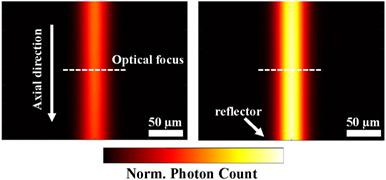当前位置:
X-MOL 学术
›
J. Biophotonics
›
论文详情
Our official English website, www.x-mol.net, welcomes your
feedback! (Note: you will need to create a separate account there.)
Near‐infrared double‐illumination optical‐resolution photoacoustic microscopy
Journal of Biophotonics ( IF 2.0 ) Pub Date : 2020-11-18 , DOI: 10.1002/jbio.202000392 Mingsheng Li 1 , Jiawei Shi 2 , Canice Chun-Yin Yiu 2 , Can Li 3 , Kenneth Kin-Yip Wong 2 , Lidai Wang 1, 4
Journal of Biophotonics ( IF 2.0 ) Pub Date : 2020-11-18 , DOI: 10.1002/jbio.202000392 Mingsheng Li 1 , Jiawei Shi 2 , Canice Chun-Yin Yiu 2 , Can Li 3 , Kenneth Kin-Yip Wong 2 , Lidai Wang 1, 4
Affiliation

|
Label‐free chemical bond imaging is of great importance in biology and medicine. Photoacoustic imaging at the third near‐infrared windows (1600‐1870 nm, near‐infrared‐III) provides a stable molecular vibrational imaging tool for lipid‐rich tissue owing to the first overtone transition of the CH bond at 1.7 μm. However, lacking high‐energy pulsed laser sources at 1.7 μm and the strong water absorption significantly limit the signal‐to‐noise ratio of the lipid imaging, especially for thin lipid tissues. To circumvent this barrier, we develop near‐infrared‐III double‐illumination optical‐resolution photoacoustic microscopy (DIOR‐PAM) for improving the sensitivity of label‐free lipid imaging. Using the same laser, DIOR‐PAM can enhance the sensitivity by nearly 100%, which we prove in the Monte Carlo simulation. We experimentally demonstrated 50% ~ 100% sensitivity enhancements on nonbiological and biological lipid‐rich samples.
中文翻译:

近红外双照明光学分辨率光声显微镜
无标记化学键成像在生物学和医学中非常重要。在第三近红外窗的光声成像(1600年至1870年纳米,近红外-III)提供了由于C的第一泛音过渡富含脂质的组织稳定的分子振动成像工具在1.7 H键 μ米。然而,缺乏高能量脉冲激光源中的1.7 μm和强大的吸水率显着限制了脂质成像的信噪比,特别是对于薄的脂质组织。为了克服这一障碍,我们开发了近红外III双重照明光学分辨率光声显微镜(DIOR-PAM),以提高无标记脂质成像的灵敏度。使用相同的激光器,DIOR‐PAM可以将灵敏度提高近100%,这在蒙特卡洛仿真中得到了证明。我们通过实验证明了对非生物和生物脂质含量高的样品的灵敏度提高了50%〜100%。
更新日期:2020-11-18

中文翻译:

近红外双照明光学分辨率光声显微镜
无标记化学键成像在生物学和医学中非常重要。在第三近红外窗的光声成像(1600年至1870年纳米,近红外-III)提供了由于C的第一泛音过渡富含脂质的组织稳定的分子振动成像工具在1.7 H键 μ米。然而,缺乏高能量脉冲激光源中的1.7 μm和强大的吸水率显着限制了脂质成像的信噪比,特别是对于薄的脂质组织。为了克服这一障碍,我们开发了近红外III双重照明光学分辨率光声显微镜(DIOR-PAM),以提高无标记脂质成像的灵敏度。使用相同的激光器,DIOR‐PAM可以将灵敏度提高近100%,这在蒙特卡洛仿真中得到了证明。我们通过实验证明了对非生物和生物脂质含量高的样品的灵敏度提高了50%〜100%。












































 京公网安备 11010802027423号
京公网安备 11010802027423号